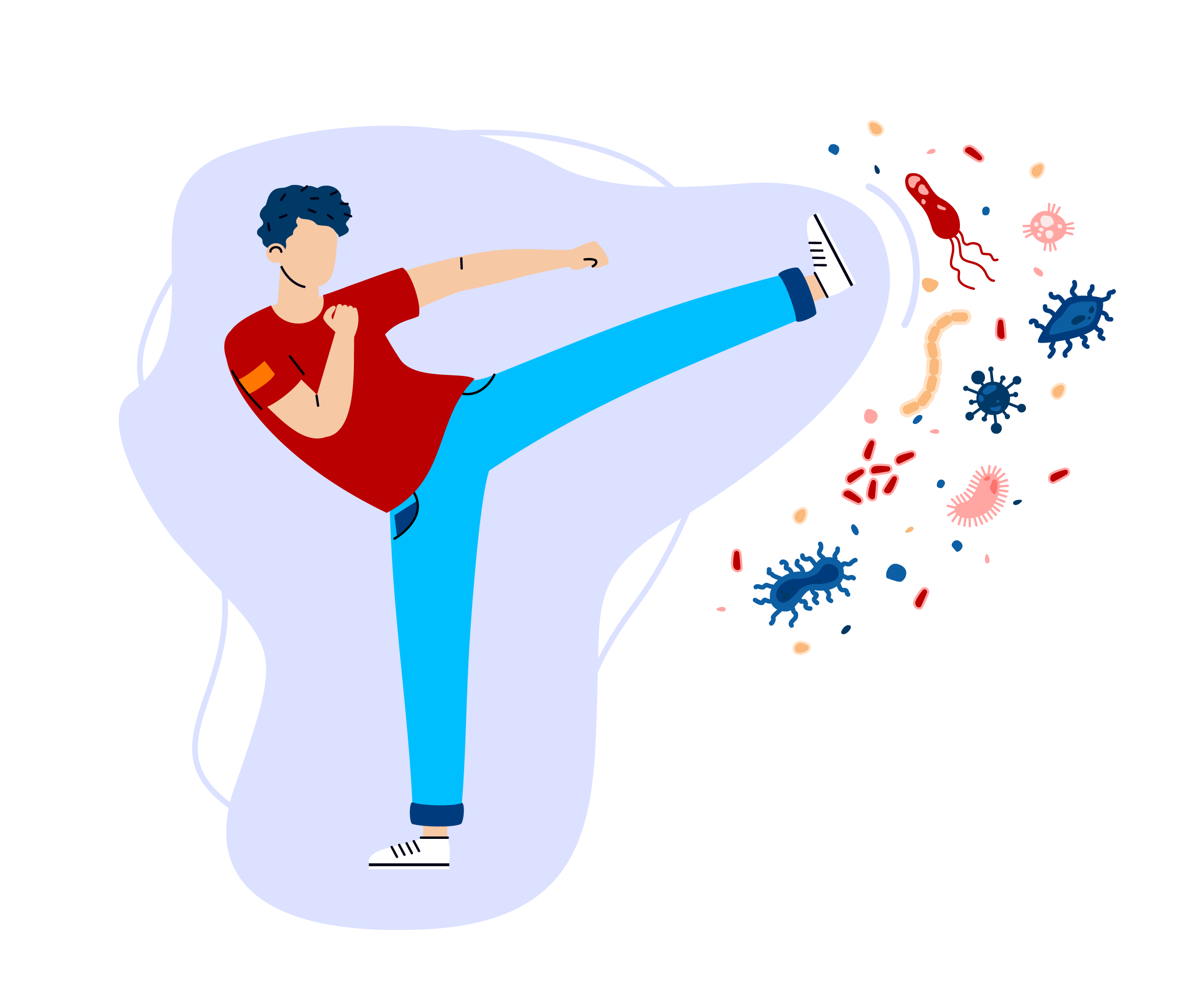
Resistance training offers more health benefits besides strengthening and toning your muscles, and contributing to weight loss. Boosting your immunity is something to consider all year round. But what does resistance training have to do with your immunity?
A well-balanced immune system calls for strong muscles, and they in turn call for a balanced immune system. Let’s look at how immune and musculoskeletal health support each other, and how your decisions now can change your future.

Muscle Mass: A DIY Shield?
In news from 2020 that should have gone viral, a lab study found that a strong, substantial amount of muscle can support the immune system during serious illness. Although it was performed on mice, the researchers from Heidelberg’s German Cancer Research Center note that it is likely to be relevant for humans.
Muscle mass is incredibly crucial for immune health, which is just one more reason to add resistance training to your workout routine. During infections, the researchers found that muscle tissue increases its production of IL-15. This is an immune signaling chemical that helps your memory cells grow, which both “remember” and fight infections. What’s more, it also helps to create a protective environment for these cells. Some memory cells had traveled inside the muscles, and as a result, maintained their ability to divide and function. Mice that couldn’t produce IL-15 had a higher proportion of exhausted immune cells, and these produced more immune-suppressing chemicals.

Resistance Training: A Long-Term Investment
Low muscle mass doesn’t seem to be a threat at first. The IL-15 it produces doesn’t affect your ability to make new immune cells. What it does do is protect them against dysfunction, exhaustion, and death. This is why you may still avoid common, self-limiting infections, but it’s the more difficult illnesses that can take hold and turn dangerous. Constant stimulation and inflammation wears immune cells down if they don’t have a place to rest.
Keeping your memory cells, also known as CD8+ T-cells, in good condition is essential to your long-term health. They produce chemicals necessary for the immune response, remove virus-infected cells and cancer cells before they can grow out of control, and some transform into memory cells, which can live for many years.
Can Resistance Training Help Prevent Cancer?
CD8 cells’ ability to remove cancer cells before they grow into a tumor may be one reason why strength training could reduce your risk of cancer. A large population study found that strength training twice a week lowered the risk of dying from cancer by 31%. It also lengthened participants’ average lifespan more than cardio workouts. We aren’t saying it’s a great idea to skip cardio, but doing both types of exercise is important. Better yet, gym-based strength training reduced cancer deaths by 39%, and some models of calculating the results showed that the risk was cut in half.
As cancer treatment moves towards immunotherapies, maintaining muscle mass will likely become even more crucial. Some of the best new treatments involve handing immune cells the genetic instructions to fight cancer, as detectable disease is too advanced for them to do this alone. Others allow immune cells that have already figured out how to attack cancer to simply grow with minimal disturbance, and inject them back into the tumor once their numbers are high enough.
How to Protect Muscle Mass Against Age and Illness
As muscle is so crucial to our overall health, how do we protect it? Strength training or resistance training such as doing calisthenics is always a must, but there are certain biochemical issues that worsen with aging and disease that you must also address.
Macronutrient and Exercise Recommendations
First, let’s start with the basics. As one of my health coach friends often explains, the most important step in protecting lean muscle mass is eating enough protein and calories, and counting macros. She meets many older, female clients who are afraid of eating too much, even though they need adequate protein the most. An Australian study on nutrient intake backs up her experience, with participants having 0.81kg less muscle mass if they didn’t consume the recommended amount of protein. Iron, calcium, and zinc were also linked with a greater amount of muscle tissue. As for how much protein you should eat every day, around one gram per kilogram of body weight (or one gram for every two pounds) is the typical recommendation. Strength training is most effective when you incorporate two 30-60 minute sessions into your weekly routine. Don’t overdo it, because excess exercise can increase your risk of injury and cause muscle damage.
Inflammation and Oxidative Stress
Inflammation and oxidative stress are two factors at the root of muscle loss, including in cases of cancer. Fortunately, research shows that combining exercise with anti-inflammatory supplements, such as omega-3 fatty acids, can be protective. A combination of a 2,000mg omega-3 fatty acid supplement and personalized exercise plans increased participants’ chances of regaining muscle tissue in one study, with better adherence leading to stronger results.
Vitamin D, which our bodies produce from sunlight, could also help prevent muscle loss. A study involving more than 4,000 men over the age of 70 found that low levels of vitamin D (less than 21ng/mL) was linked to almost double the risk of frailty. Men who were healthy when the study began had an over 50% higher risk of becoming frail if they were deficient in vitamin D. If you can’t get enough sunlight all year round because you live too far north, oily fish such as sardines or salmon are a rich source.
Strength-Specific Supplements
If you’re struggling to build muscle, there are some foods and supplements that have targeted effects.
Epicatechin
One of these is epicatechin, a powerful antioxidant present in dark chocolate and green tea. Epicatechin works by reducing the activity of a substance known as myostatin and increasing follistatin. Myostatin acts as the “brakes” on muscle growth, while follistatin prevents this braking system from working. When you see animals with a natural mutation that increases follistatin activity, they look like they’ve been hitting the gym. And steroids.
But what about humans? To test it out, a clinical trial studied a combination of strength training, performed in three 45-minute sessions every week, and a dose of epicatechin personalized to 1mg per kilogram of body weight. After eight weeks, volunteers’ follistatin levels rose, myostatin fell, and most importantly, their muscle mass and strength rose. Those taking epicatechin and strength training enjoyed more improvements than the participants only using one intervention. And if you’re reading this because you just can’t seem to build muscle like you used to, take heart: the volunteers were aged between 65 and 75.
Epicatechin is found in dark chocolate and green tea, but you may need supplementation. 100 grams of dark chocolate contains around 41mg of epicatechin, while 100g of brewed green tea or black grapes have a little over 8mg. After workouts, I personally like to buy a smoothie with protein powder and cacao. Not only do I love the taste of dark chocolate, but I can get the building blocks of new or repaired muscle tissue alongside a follistatin-boosting effect.
Creatine
Creatine is another option if you’re looking for something that shines the most with short-term use. Although our muscles can make their own creatine, which is necessary for energy production, a lack of exercise or a vegetarian diet may deplete it. Fortunately, trials show that loading doses of creatine can boost strength, fatigue resistance, and functional independence. These doses reach up to 0.3 grams per kilogram of body weight, and can be taken for up to 20 days. Creatine is found in meat at around 3-4 grams per kilogram, so you can only use food to maintain your levels.
Take Control of Your Health With DNA Insights
A healthy level of muscle mass is vital for not only our physical fitness, but also our immune system’s ability to protect us against infections and even cancer. It doesn’t matter who you are, resistance training is a must.
However, we each have a unique set of strengths and vulnerabilities when it comes to our health. A Premium CircleDNA test can provide you with information about the ideal diet and exercise program for you, based on your genetic body composition. It will also provide you with information about your genetic risk of injury, greater nutrient demands, and how easy or hard it might be to gain muscle based on your genetic body type.
References
- Skeletal muscle antagonizes antiviral CD8+ T cell exhaustion, Science Advances, https://www.science.org/doi/10.1126/sciadv.aba3458
- CD8+ T cell metabolism in infection and cancer, Nature Reviews: Immunology, https://www.ncbi.nlm.nih.gov/pmc/articles/PMC8806153/
- Does Strength-Promoting Exercise Confer Unique Health Benefits? A Pooled Analysis of Data on 11 Population Cohorts With All-Cause, Cancer, and Cardiovascular Mortality Endpoints, American Journal of Epidemiology, https://academic.oup.com/aje/article/187/5/1102/4582884
- Associations between dietary nutrient intake and muscle mass and strength in community-dwelling older adults: the Tasmanian Older Adult Cohort Study, Journal of the American Geriatrics Society, https://pubmed.ncbi.nlm.nih.gov/21054294/
- Feasibility of a multimodal intervention on malnutrition in patients with lung cancer during primary anti-neoplastic treatment, Clinical Nutrition, https://pubmed.ncbi.nlm.nih.gov/32600857/
- Low vitamin D status is an independent predictor of increased frailty and all-cause mortality in older men: the Health in Men Study, The Journal of clinical endocrinology and metabolism, https://pubmed.ncbi.nlm.nih.gov/23788685/
- Improvement in Skeletal Muscle Strength and Plasma Levels of Follistatin and Myostatin Induced by an 8-Week Resistance Training and Epicatechin Supplementation in Sarcopenic Older Adults, Journal of aging and physical activity, https://pubmed.ncbi.nlm.nih.gov/30299198/
- Foods With Epicatechin & Catechin, SFGate, https://healthyeating.sfgate.com/foods-epicatechin-catechin-1310.html Use of creatine in the elderly and evidence for effects on cognitive function in young and old, Amino Acids, https://pubmed.ncbi.nlm.nih.gov/21394604/







This Post Has One Comment
Comments are closed.